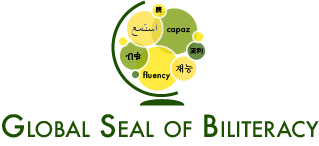Türkçe Dört Beceri Sınavı
The Turkish Four Skills Exam assesses the reading, listening, speaking, and writing abilities of adults learning Turkish as a foreign language. It follows CEFR standards and is designed to support Turkish language education policies with an internationally recognized, standardized test.
Exam Overview:
Click here for an overview of the test.
Where is this test recognized?
Internationally recognized anywhere a B2 or C1 CEFR score is accepted (Alte Q-Mark).
Is it accepted by Global Seal of Biliteracy?
Yes! You can earn a Global Seal by achieving these scores in all sections:
Functional Fluency: B1
Working Fluency: B2
Professional Fluency: C1
In order to earn a Global Seal, candidates must meet the minimum score requirement on all sections of the test.
Is a proctor required?
All Global Seal tests require proof of a proctor. Requirements for digital test takers can be found here. Reach out to the testing company to find more information.
When and Where does this test take place?
The test is conducted digitally, with students using computers and specialized equipment to complete the assessment. Select regions may also include a paper-based component for research purposes. For details on upcoming test dates and locations, please refer to official announcements.
What is the cost?
Please contact the testing provider for pricing information.
TEST FORMAT:
The Turkish Four Skills Exam (TDBS) is a computer-based test conducted in electronic exam centers, assessing reading, listening, speaking, and writing through a mix of multiple-choice and open-ended questions. Candidates use noise-canceling headphones for listening, special microphones for speaking, and either keyboards or handwriting (in select cases) for writing. The test follows international standards to ensure accuracy and fairness.
-
Students answer multiple-choice and open-ended questions based on given texts.
-
Candidates listen to audio recordings through noise-canceling headphones and respond to questions.
-
Responses are recorded using specialized microphones, assessing pronunciation, fluency, and coherence.
-
Test-takers complete written tasks, either typed on a computer or (in some cases) handwritten on paper for comparison.


